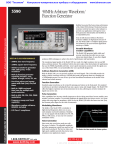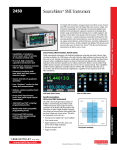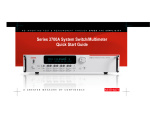Download Keithley 2230-30-1 Guide - Portland State University
Transcript
DC POWER SUPPLY GUIDE Keithley 2230-30-1 Department of Electrical & Computer Engineering Keithley 2230-30-1 DC Power Supply Guide v1.0 Portland State University 1 – Introduction This guide provides instructions for operating the Keithley 2230-30-1 DC power supply. The unit outputs DC voltage and current to supply external electrical circuits with power. Features: • Triple isolated DC output channels. Each is independently adjustable. o CH1, CH2 : 0 to 30 V, 0 to 1.5 A o CH3 : 0 to 6 V, 0 to 5 A • Overvoltage protection • Four-digit voltage and current displays • Push-button controls, numeric keypad, multipurpose knob • Double voltage and double current modes • Setup memory • Programmable 1 Keithley 2230-30-1 DC Power Supply Guide v1.0 Portland State University 2 – Instrument Front Panel Arrow keys & Enter button Readout display Readings or settings Top: voltage Bot: current Multipurpose knob Channel select buttons Power button V-Set, I-Set, Menu (LOCAL), OUTPUT On/Off function buttons Keypad Save, Recall function buttons CH1, CH2, CH3 output connectors Figure 1: Keithley 2230-30-1 front panel Copyright © Keithley Instruments, Inc. Power button This switch turns the entire power supply either on or off. CH1, CH2, CH3 output connectors The power supply has three sets of output connectors – one for each output channel. Each set consists of positive (+) and negative (-) terminal posts. 2 Keithley 2230-30-1 DC Power Supply Guide v1.0 Portland State University Readout display A two line alphanumeric readout shows the state of the output channels CH1, CH2, and CH3. The top row displays the voltage (in volts), while the bottom row shows the current (in amperes). Underline Cursor Voltage Current Figure 2: Sample readout (output off, CH1 selected) • If the outputs are disabled (off), then one row displays the <OFF> message. • If the outputs are enabled (on), the power supply senses the output values. The readout shows the measured output voltage and the measured load current for each channel, along with a CV or CC message to indicate if the channel is operating in constant voltage or constant current mode. • If a voltage or current limit is being adjusted, the readout temporarily displays the new value, which blinks to indicate input mode. Once entered, the readout reverts to showing the measured value. • An underline cursor highlights the channel that is selected for adjustment. • If the settings menu is accessed, the readout shows the existing values and options. Channel select buttons (CH1, CH2, CH3) Press one of these buttons to select an output channel for adjustment, such as changing the voltage limit or current limit. The selected channel is highlighted by an underline cursor on the readout. Keypad Use the keypad to enter numeric values for the voltage or current limits of the selected output channel. Keys for the digits 0 through 9 and the decimal point are available. Enter key • After inputting a numeric value, press the Enter key to complete entry. • For Menu, Save, or Recall, push Enter to select an item. Esc key Use Esc to cancel a pending operation or to exit a menu. 3 Keithley 2230-30-1 DC Power Supply Guide v1.0 Portland State University Arrow keys • For adjusting a numeric value, the left and right arrows move the cursor to individual digits within the value. The up arrow increments the selected digit, while the down arrow decrements it. • In Menu mode, the up and down arrows scroll through the list of available menu items. Multipurpose knob • For adjusting a numeric value, rotating the knob clockwise increments the value, while rotating the knob counter-clockwise decrements it. • In Menu mode, the knob scrolls through the list of available menu items. Note: When incrementing or decrementing a numeric value using the up/down arrow keys or knob, the currently underlined digit determines the step size. Menu, OUTPUT On/Off function buttons • Menu Accesses the settings menu. The up and down arrow keys scroll through the menu, while the Enter key selects a menu item. The Esc key exits the menu. • OUTPUT On/Off Enables or disables the DC outputs. Each press of the button toggles the output state. All three outputs are turned on or off simultaneously, regardless of which channel is selected. V-Set, I-Set function buttons • V-Set Sets the desired output voltage. • I-Set Sets the maximum output current. Notes: 1. I-Set determines the maximum current that an attached load is allowed to draw. The actual load current may be any value between zero and the current limit. If the load current exceeds the limit, then the power supply switches to constant current mode. 2. V-Set and I-Set can be accessed at any time, regardless if the output is enabled or disabled. 3. Voltage and current limits for all three outputs are stored in non-volatile memory, so the power supply retains its last used settings even when it is turned off. 4 Keithley 2230-30-1 DC Power Supply Guide v1.0 Portland State University Save, Recall function buttons • Save Up to 30 setups can be saved to non-volatile memory. Each setup consists of the voltage limit, current limit, and protection setting. When Save is pressed, this message appears on the readout: “Save (1-30) X”, where X is a memory location from 1 to 30. Use the keypad, up/down arrow keys, or knob to pick the desired location. Press Enter to complete the save operation, or Esc to cancel. • Recall Previously saved setups can be recalled from memory. A setup consists of the voltage limit, current limit, and protection setting. Recalling a setup will overwrite the existing limit and protection values. When Recall is pressed, this message appears on the readout: “Recall (1-30) X”, where X is a memory location from 1 to 30. Use the keypad, up/down arrow keys, or knob to pick the desired location. Press Enter to complete the recall operation, or Esc to cancel. 5 Keithley 2230-30-1 DC Power Supply Guide v1.0 Portland State University 3 – General Operating Procedure Note: The → symbol indicates a sequence of buttons to push. For safe operation of the DC power supply, follow this procedure: 1. Turn off the power supply. 2. Configure the output terminals as required. (See Appendix 1: Typical Output Terminal Connections) 3. Connect your circuit to the power supply’s output terminal posts. 4. Turn on the power supply, but do not enable the outputs yet. 5. For each output you intend to use a. Select the channel. The underline cursor highlights the selected channel. To select Buttons to press Channel 1 CH1 Channel 2 CH2 Channel 3 CH3 b. Set the desired voltage limit and current limit for the selected channel: To set Buttons to press Voltage V-Set → Numeric value → Enter Current I-Set → Numeric value → Enter Note: Numeric value consists of digits (and decimal point, if needed) that are entered via the keypad, arrow keys, or knob. Data entry is completed by pushing the Enter button. 6. Enable the outputs. The <OFF> message on the readout disappears. Button to press OUTPUT On/Off 7. Test your circuit. 8. Once you are done testing, disable the outputs. The <OFF> message reappears. Button to press OUTPUT On/Off 6 Keithley 2230-30-1 DC Power Supply Guide v1.0 Portland State University Example: Set the voltage of CH1 to 5 volts with a current limit of 1.25 amperes. 1. Select CH1: CH1 2. Set the voltage limit: V-Set → 5 → Enter 3. Set the current limit: I-Set → 1.25 → Enter 4 – Negative Voltages To configure the 2230-30-1 to supply negative voltages, the output connectors need to be physically wired in a specific way (See Appendix 1: Typical Output Terminal Connections). Regardless of the expected polarities, all voltage and current limits are entered as positive numbers. 5 – Constant Voltage versus Constant Current Output The power supply is designed to provide either a constant voltage (CV) or a constant current (CC) to an attached load. The existing voltage limit, current limit, and load determine whether the power supply attempts to keep the voltage constant or the current constant. The 2230-30-1 automatically switches between these operating modes. Example: Suppose CH2 is set to 3.3 volts with a current limit of 0.25 amperes. As long as the load attached to CH2 does not use more than 0.25 A of current, the power supply will keep the supplied voltage constant at 3.3 V. The “CV” message is shown on the CH2 readout. However, if the load attempts to draw more than 0.25 A of current, the power supply will limit the current to 0.25 A and allow the supplied voltage level to drop below 3.3 V. In this case, the “CC” message is displayed. 7 Keithley 2230-30-1 DC Power Supply Guide v1.0 Portland State University 6 – Overvoltage Protection A channel’s maximum allowed output voltage can be adjusted to protect sensitive test circuits from an accidental overvoltage condition. When protection is on, a user cannot enter a voltage limit larger than the defined maximum. Protection can be turned on or off individually for each channel. Here is the setup procedure: 1. Press the Menu button. 2. Select the “Protection Settings” menu item and press Enter. 3. Select the “Max Volt Set” item and press Enter. 4. Select the “Max V CH1” (or CH2 or CH3) item and press Enter. 5. Select the “On” item and press Enter. The display will change to show this: MaxVoltage Set MaxVolt = value V (where value is the existing maximum in volts) 6. Adjust the MaxVolt to the desired value. 7 – Resetting the Power Supply The power supply’s settings can be restored to their factory default values by following these steps: 1. Press the Menu button. 2. Select the “Default Set” menu item and press Enter. 3. Select the “Yes” item and press Enter. Note: For all channels, the default output voltage and current are 1 V and 0.1 A, respectively, with overvoltage protection disabled. 8 Keithley 2230-30-1 DC Power Supply Guide v1.0 Portland State University Appendix 1 – Typical Output Terminal Connections • Although only channels 1 and 2 are shown in the drawings, all three outputs work similarly. • Although not displayed in the equivalent circuit drawings, all practical power supplies have an internal source resistance Rs. • The curved connections can be made by using insulated wire. Single output (isolated) V1 + Load 1 + CH1 CH2 – – Equivalent Circuit V1 + – Load 1 V1 + – Load 1 Dual outputs (isolated) V1 + Load 1 + V 2 CH1 CH2 – – Equivalent Circuit Load 2 V2 + – Load 2 The circuits are completely isolated from each other. Figure 3: Connections for circuits requiring isolation 9 Keithley 2230-30-1 DC Power Supply Guide v1.0 Portland State University Dual positive outputs (common) V1 + Load 1 + V 2 CH1 CH2 – – Equivalent Circuit +V1 V1 Load 2 + – +V2 V2 Load 1 + – Load 2 Common reference Dual negative outputs (common) Common reference V1 + Load 1 + V2 CH1 CH2 – – Equivalent Circuit V1 Load 2 + – V2 Load 1 + – Load 2 −V2 −V1 Negative & positive outputs (common) V1 + Load 1 V1 + V 2 CH1 CH2 – – +V1 + – Load 1 Equivalent Circuit Common reference Load 2 V2 + – Load 2 −V2 Figure 4: Connections for circuits requiring a common ground reference VSS is the op-amp supply voltage. Vin R2 R2 VSS + +VSS R1 − + Vout + V SS Vin R1 − Connection CH1 −VSS – CH2 – Common reference + +VSS −VSS Figure 5: Example of inverting operational amplifier with bipolar power supply 10 Vout Keithley 2230-30-1 DC Power Supply Guide v1.0 Portland State University Appendix 2 – Technical Specifications Table 1: Manufacturer’s specifications for 2230-30-1 model DC Output Rating Load Regulation Line Regulation Ripple and Noise Setting Resolution Setting Accuracy Meter Resolution Meter Accuracy Output Channel 1 Output Channel 2 Output Channel 3 Voltage 0 to 30 V 0 to 30 V 0 to 6 V Current 0 to 1.5 A 0 to 1.5 A 0 to 5 A Voltage < 0.01% + 3 mV < 0.01% + 3 mV < 0.01% + 3 mV Current < 0.01% + 3 mA < 0.01% + 3 mA < 0.01% + 3 mA Voltage < 0.01% + 3 mV < 0.01% + 3 mV < 0.01% + 3 mV Current < 0.1% + 3 mA < 0.1% + 3 mA < 0.1% + 3 mA Voltage < 1 mV rms < 3 mV p-p < 1 mV rms < 3 mV p-p < 1 mV rms < 3 mV p-p Current < 5 mA rms < 5 mA rms < 6 mA rms Voltage 1 mV 1 mV 1 mV Current 1 mA 1 mA 1 mA Voltage ±0.03% + 10 mV ±0.03% + 10 mV ±0.03% + 10 mV Current ±0.1% + 5 mA ±0.1% + 5 mA ±0.1% + 5 mA Voltage 1 mV 1 mV 1 mV Current 1 mA 1 mA 1 mA Voltage ±0.03% + 10 mV ±0.03% + 10 mV ±0.03% + 10 mV Current ±0.1% + 5 mA ±0.1% + 5 mA ±0.1% + 5 mA 11 Keithley 2230-30-1 DC Power Supply Guide v1.0 Portland State University Appendix 3 – References [1] Models 2220 and 2230 Multi-Channel Programmable DC Power Supplies Data Sheet, Keithley Instruments, Inc. [2] Series 2200 Multichannel Programmable DC Power Supplies User Manual, Keithley Instruments, Inc. 12






















